Working at Heights
3. Scaffolding
Conditions for erecting, using and dismantling scaffolding.
| ERECTION, USE AND DISMANTLING OF SCAFFOLDING. | |||
|---|---|---|---|
| Type of scaffolding | Erection, use and dismantling plan | Supervision of erection, dismantling or modification / inspections |
Execution of erection, dismantling or modification (HS126) |
| COMPLEX AND WITHOUT THE “CE” MARK (1) |
MANDATORY Carried out by a person with university qualifications for the job |
Person with university or vocational qualifications for the job | Workers with suitable specific training for the foreseeable operations, their hazards and prevention, protection and emergency measures |
| SIMPLE WITH NO “CE” MARK | UNNECESSARY | Person with at least 2 years experience accredited by the firm + Basic level 50 h |
|
Spanish Royal Decree 2177/2005 regarding temporary work at heights
(1) Scaffolding whose COMPLEXITY obligatorily requires an Erection, Usage and Dismantling Plan: Scaffolding of some of the following types:
- Suspended platforms of variable height and mast-type elevating platforms.
- Scaffolding of over 6 m in height (crown of the scaffolding) or which covers a span or distances between supports of more than 8 metres.
- Outdoor scaffolding of over 24 metres in height from its support on the ground or floor.
- Mobile access towers and work towers for access or working at more than 6 metres (operation point).
When erection is carried and supervised by ISASTUR Group personnel, the supervisor of said erection must be qualified in keeping with the stipulations of the procedure for Qualifying workers for work involving a special hazard.
Scaffolding is to be properly planned, erected and maintained so as to avoid its accidental collapse or displacement. To this end, all scaffolding must be calculated in one of the following ways:
- SIMPLE scaffolding: a Scaffolding Calculation Note is available that has been chosen in accordance with the setup to use (manufacturer, provider or supplier) and/or erection is carried out according to a generally recognised standard setup.
- COMPLEX scaffolding: its erection and dismantling is carried out according to the Specific Erection Plan drawn up to this effect (or corresponding TI).
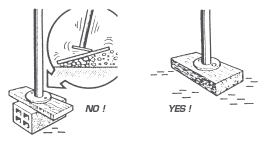 The scaffolding must rest on the ground or on solid supports, for example pieces of wood that present sufficient settlement, bearing in mind the strength of the ground. It must never rest on bricks, boxes, etc. |
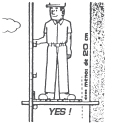 Rails must be installed to impede people, materials and tools from falling. The gap between the scaffolding platform and the facade of the building must be as small as possible. |
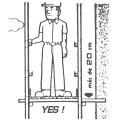 If this gap cannot be respected, a rail will have to be installed on the side of the facade. . |
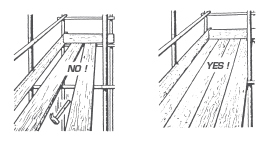 Scaffolding platforms must be robust, be joined together and free of any hindrance. |
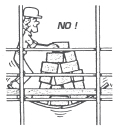 Do not load the platforms with an excessive amounts of materials. |
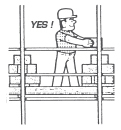 Share them out over the work platform.. |
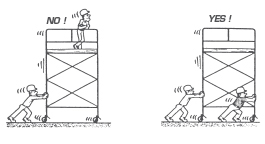 Portable scaffolding must be displaced slowly, preferably in the longitudinal sense, over obstacle-free ground. Nobody is allowed on the scaffolding when it is being moved. Before any displacement, ensure that no object can fall from it. |
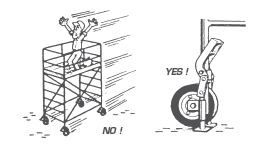 Before climbing onto portable scaffolding, block the wheels and, if necessary, install stabilizing elements. |
|




